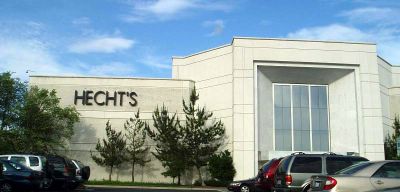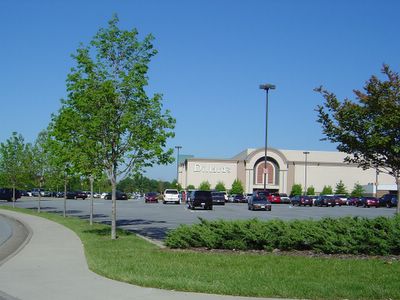
Essay time, y'all. It's a long one, but I thought it came out pretty good.
__________
What does being a department store mean these days? That’s a tough question, because the only true ‘department stores’ these days are the Big Three discounters: Wal-Mart, Kmart and Target, and to a lesser extent, Sears, Roebuck and Co and Amazon.com.
A department store, by definition, is a retailer that carries a wide variety of goods and services under one roof (or internet storefront). The perpetrators still calling themselves department stores are actually large apparel specialty stores with token home items thrown in for good measure. Take a look at any major department store chain and you’ll see this for yourself.
It used to be very different. In the days of yore, ‘merchant princes’ started from humble beginnings and created massive downtown emporiums where one could spend an entire day and purchase nearly everything one needed in a single stop. Those merchants were respected community leaders and many held their stores in such high regard that they saw them as extensions of the community: giving to charities, providing venues for events, et cetera. The public reciprocated, granting stores like Macy’s, Hudson’s and Marshall Field’s a place in their hearts and homes. Suburbanization eroded some of the civic aspects of the department store, replaced in part by the shopping center, which functioned as a department store writ large.
While the mall was a boom at first for the department store operator, things quickly turned sour. With malls came competition. The suburbs were vast and unclaimed, the polar opposite of downtown, and in this frontier of the new, fresh ideas crept into consumer consciousness. Discount stores imitated the department store’s merchandising at lower prices, and intrepid businessmen began creating what are now called ‘big box’ stores that specialize in a limited range of products sold in a high volume.
The first reaction by department stores was to ignore the trends and build more stores. When that didn’t work, the stores cut back on inventory, leaving furniture, toys, hardware and other ‘hard goods’ markets to the specialists. When that didn’t work, the more prosperous chains began swallowing up the weaker ones, leading to a pervasive uniform blandness.
The reaction by consumers was clear. While many still ventured to department stores out of habit or for ‘fashion,’ many more began to embrace a new kind of retail reality. Discounters became more sophisticated, big box stores broadened their lines and specialty stores began to embrace ‘lifestyle merchandising:’ creating mythical worlds of their own to capture consumers wanting to live idealized lifestyles. In essence, the rest of the retail industry embraced the traditional department store model, while department stores became parodies of their former selves.
The last ten years have seen calls to ‘reinvent’ the department store, led notably by Federated Department Stores. There was a definite movement towards making stores easier to shop, with broader aisles, better lighting, competitive pricing and an embrace of youth culture in order to stop a three-decade slide of irrelevance to the channel by younger people, who find their needs are better served in competing retail formats.
Though shopping carts and flashy new displays certainly knocked the dust off an increasingly obscure retail format, the changes were largely ignored. Compare this with what most people still equated with the department store industry in this generation: stodgy fashions, indifferent sales associates, high prices partially obscured by never-ending ‘sale events’ with coupons that are worthless on anything but store brands, and boring look-alike stores with few choices beyond clothes and basic housewares.

The Federated-May merger
Two companies that have stood victorious in the battles that have led most department store operators out of business have a new plan for survival. Federated and The May Department Stores Company have proposed a merger that will create a 1000-store behemoth larger than its three biggest direct competitors combined.
The new operation would presumably bring together the last of the strong department store nameplates into a united company to battle the Wal-Marts and Best Buys of the world, giving new hope that the quasi-department store formats both embrace will survive into the next generation.
From an investment standpoint in the short term, the idea is a sound one. May and Federated together could cherry-pick the most profitable locations in their combined portfolio, utilize the nameplates with the greatest impact and essentially corner the national middle-aged, middle-class market that still shops their stores, something no other company of its ilk has been able to do.
The combined buying power of the new chain could force down prices on popular merchandise by forcing vendors to make concessions to keep their business, a la Wal-Mart. In that regard, the new Federated could be a powerhouse.
But in the long term, the idea makes no sense. Because neither company has been able to embrace the youth market, win on price against competing formats, or genuinely make their stores compelling places to shop on their own, who is to say that the new company would fare any better?
In addition, to achieve the kinds of cost savings that the companies would have to produce to be truly viable, more uniformity in merchandising and store design would presumably have to take place. These practices have led to eroding returns at department stores for years, as consumers searched for ‘something different.’

Examples
The idea of consolidation in retail has been around for as long as retail itself. Certainly, no retailer can survive if the costs of doing business outweigh the profits. Take for example the case of W.T. Grant, a once successful company that borrowed and expanded itself into bankruptcy, continuing to pay dividends to shareholders despite serious sales problems.
Larger companies can exact cost savings from combining operations and streamlining redundancy. In doing so, however, the risk becomes the creation of completely uniform shopping experiences at each store. Dillard’s, Inc., is an example. While the company’s back-office operations are efficient and admired by the retail community, the in-store experience is so similar to its competitors and its stores resemble each other so much that Dillard’s becomes in a way, remarkably unremarkable by design.
While Federated and May, together or apart, are in no danger of going the way of Grant’s in the foreseeable future, the Dillard’s example does ring true. While Dillard’s became dominant and leveraged its operation on a near national-scale, the stores themselves became bland. As Federated and May have walked down similar paths in this regard in the recent past, a combination of the two without real in-store innovation could lead to more indifference.

The future
The future of the department store lies in diversification and not mergers. Federated, especially in its Macy’s division, needs to bring the energy and breadth of merchandise of their largest stores to its smaller markets, making those stores more compelling to shop and a real alternative to their competition. May needs to broaden its product selection beyond the basics and embrace both higher-fashion and higher-quality goods along with a more developed presentation in its home store. Both chains need to embrace food and leisure items and its possibilities for shopper retention and awareness.
Without substantive changes, the department store industry as a whole will become less relevant with passing time. While the public at large may not miss them in the long term, the short term will prove disastrous for the real estate and job markets. Millions of square feet of retail space could be left empty and thousands of jobs could be lost if May and/or Federated refuse to diversify or merge together and fail.
While department store competitors like Belk, Bon-Ton, and Gottschalk’s could absorb some of the losses as growth to their business, the same companies suffer from many of the same problems that the giant chains do.
Many of the latter day rules for retailing no longer apply, so an embrace of the founding principles that made department stores great in the first place could revive the industry. Simply staying the course and merging into larger and larger concerns will eventually lead the industry to ruin.
An excellent essay, Steve.
ReplyDeleteThanks, Mitch.
ReplyDeleteThe inspiration to write it came from the fact that so many modern retail formats have embraced department store-style merchandising, but yet not modern department stores.
Not only is this ironic, it has been financially disasterous for the some of the largest retailers in the industry.
As a pesron who loves department stores, it's sad to watch them die when taking a page or two from their own old playbooks might save them.